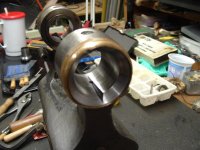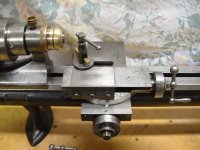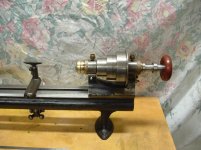aninventor
Aluminum
- Joined
- Dec 31, 2009
- Location
- Ohio - USA
I have a Stark #3 lathe with plain cone bearings in the head stock that the hardened spindle runs in and that are lubricated by drip oilers. The bearing at the spindle nose has two taper angles; a shallow angle for radial loads and a steep angle for axial loads. This lathe design is very similar to a Hardinge Cataract but predates it by about 4 decades. Stark was in business at the start of the civil war and I am guessing this lathe was manufactured some time in the 1870's or 1880's.
This lathe has a 3 step cone pulley on the spindle. What are normal and reasonable spindle speeds for this lathe?
There is a fine thread nut on the back end of the spindle that adjusts the spindle bearing slack and preloads the spindle bearings. What is the proper procedure for adjusting the spindle bearing preload on a lathe like this?
Do you need to readjust the bearing preload after using the lathe for a while and warming it up?
Is it necessary to slacken the bearing preload when you are done using the lathe for the day?
Do you need to play with the bearing preload adjustment pretty much every time you use the lathe, or is it more set it and forget it?
Are these bearings pretty robust or can they be easily damaged by misadjustment or improper operation or inadequate lubrication.
What is the proper oil to lubricate these spindle bearings with and how often and how much oil should be applied to the oilers?




This lathe has a 3 step cone pulley on the spindle. What are normal and reasonable spindle speeds for this lathe?
There is a fine thread nut on the back end of the spindle that adjusts the spindle bearing slack and preloads the spindle bearings. What is the proper procedure for adjusting the spindle bearing preload on a lathe like this?
Do you need to readjust the bearing preload after using the lathe for a while and warming it up?
Is it necessary to slacken the bearing preload when you are done using the lathe for the day?
Do you need to play with the bearing preload adjustment pretty much every time you use the lathe, or is it more set it and forget it?
Are these bearings pretty robust or can they be easily damaged by misadjustment or improper operation or inadequate lubrication.
What is the proper oil to lubricate these spindle bearings with and how often and how much oil should be applied to the oilers?









